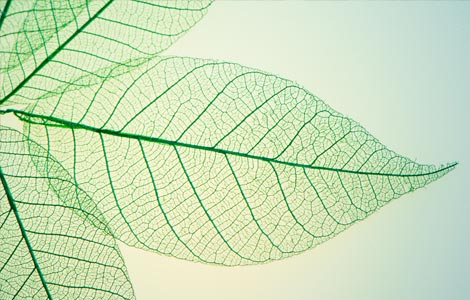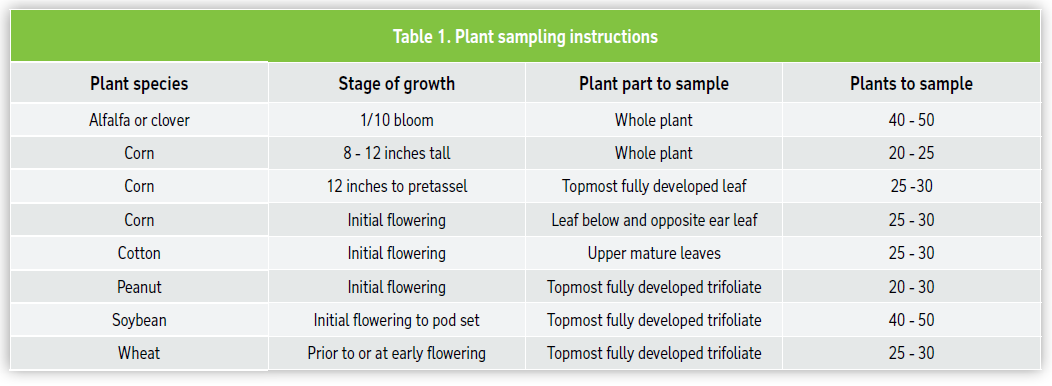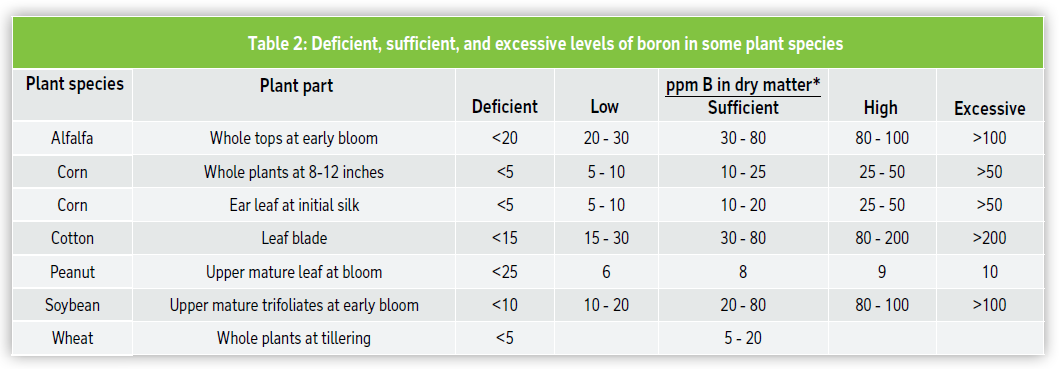
- Plant analysis can be a valuable tool in determining the general nutritional status of crops during the growing season.
- Accurate interpretation of plant analyses data requires that plant tissue samples be carefully collected and handled prior to shipment to the laboratory.
- Knowledge of the normal boron sufficiency range in a given crop helps to interpret the analytical results and to diagnose a possible boron deficiency.
Plant analysis can be a useful tool in determining the general nutritional status of crops during the growing season. It is used along with soil testing to diagnose boron (B) deficiency symptoms because some visual symptoms can result from other factors, such as low or high moisture stress, abnormally low or high temperatures, insects and diseases.
The boron content of a plant, or one of its parts, also serves as a reflection of the available boron status of the soil for the period a few weeks prior to tissue sampling.
In plant analysis, the whole plant or particular plant parts are analyzed. The results of plant analysis are reported as precise numerical concentrations in the parts per million (ppm) range, which can be compared to previously established critical levels and sufficiency ranges.
Soil tests are strongly affected by certain soil properties, notably pH, organic matter content and texture. Soil test results may not be as definitive as plant analysis in verifying boron deficient soils, but soil test results can be helpful in interpreting plant analysis results.
Both diagnostic methods should be used together to effectively evaluate the soil-plant boron status and thereby confirm a sufficiency or insufficiency of boron for a given crop.
Collecting tissue samples
Plant sampling is frequently the most limiting factor in a successful plant analysis program. Extreme care should be taken when selecting the plant part to be sampled. There can be a large variation in boron concentrations among the different parts of the same plant.
Proper sampling requires that a definite plant part be taken, such as a particular leaf, a group of leaves, or a portion of a plant at a specified time in the plant growth cycle. Sampling instructions for several agronomic crops are given in Table 1. In timing your sampling regimen, use growing degree units (GDU). By sampling each year at the same GDU interval, you can build a consistent database of boron sufficiency to identify trends.
When specific sampling instructions are not given for a particular crop, the general rule is to sample the most recently matured leaves. Young emerging leaves, older mature leaves and seed are not considered suitable plant tissues for analysis since they do not usually reflect the current nutrient status of the whole plant.
The recommended time to sample many plants usually occurs just prior to the beginning of the reproductive stage.
Accurate analysis requires that plant tissue samples be carefully collected and handled prior to shipment to the laboratory. Elemental composition of plants varies with age, the portion of the plant sampled and other factors. Therefore it is essential to follow standard sampling procedures.

Handling tissue samples
Once the plants have been sampled, proper handling of the sample becomes very important. If the plants were dusty, dust the sampled plant parts off with a light brush or wash to remove contaminants (use distilled water if possible). Caution should be practiced as B can be leached out of the sample by excessive washing.
To prevent spoilage of the plant material, the sample should be thoroughly air-dried (at 140-180°F) prior to mailing to a laboratory for analysis. Fresh plant material will decompose rapidly when placed in polyethylene bags or in tightly sealed containers unless kept under refrigeration.
Place air-dried samples in a clean paper or cloth container and close the shipping container to avoid contamination.
When sending plant samples to a laboratory for problem diagnosis, also send a note describing the problem and the conditions under which the plants were growing (the soil type and moisture situation, position on the landscape, cropping history, and fertilizers and chemicals applied for this crop).
Tissue samples taken from both normal and abnormal areas in the field can assist in the diagnosis of possible boron nutritional problems.

Interpreting analysis
The success of plant analysis as a diagnostic technique depends on the interpretation of the test results. The procedure used by many plant analysts is to compare the boron concentration in the plant tissue with the sufficiency range found in normal plants.
Tables listing deficient, sufficient, excessive and intermediate levels or ranges of boron, which have been established by research, can be obtained and also are used to interpret plant analysis results. Examples are shown in Table 2 above.
Boron sufficiency ranges of many agronomic and horticultural crops are listed in Agronomy Note: Boron Deficiency Symptoms.
Even though it may be too late to make soil applications after boron deficiencies are diagnosed through plant analysis, it is important to recognize that a problem exists so that corrective fertilizer applications can be made for the next crop.
Low boron concentrations in plant tissues which were sampled prior to flowering and seed development can be corrected by prompt foliar spray applications of Solubor®.
Download Agronomy Notes